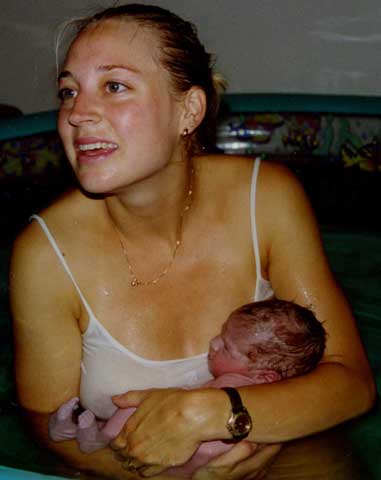
‘I’ve always loved the water’ Christina tells me. Her voice is gentle and contemplative. ‘I have a long candlelit bath every night. I feel really at home in the water, so it just seemed perfect for birthing.’
Birthing in water
When Christina was pregnant with her second child, Aluca, she began exploring the possibility of having a water birth. With Paolo, her first baby, she had given birth in a birth centre. While Christina had used water for much of her fifteen-hour labour she had to get out towards the end to give birth. During her second pregnancy she went to antenatal classes run by a midwife and saw photos of a home birth there. Christina says she thought, ‘how beautiful.’ She became increasingly sure that she wanted to birth in water, at home with her second baby.
Marco her husband wasn’t quite as sure. As a couple they did a lot of research into the subject. ‘We grew a lot as a couple during that period,’ Christina says. Meeting Shea and Sheryl their midwives helped them deal with a lot of these fears. Christina says, ‘they instilled such confidence because they were so well informed, and we knew they were not risk takers.’ Marco changed his thinking, as did Christina’s mother. ‘All my family were quite conservative in their thoughts about birthing,’ Christina tells me. ‘My mum came to all the visits at Sheryl and Shea’s and she opened her mind up too. She feels very lucky to have been part of the whole experience.’
As soon as labour started Christina says she got into her bath while Marco filled the birth pool up. ‘I thought it was going to take a bit longer but it was all very fast with Aluca. It was a three-hour labour while Paolo was fifteen hours.’
Christina’s diary entry on the day Aluca was born records how she felt, ‘a desperate urge to get into the birthing pool and I knew that was where I was safe to give birth. ‘Stepping into the birthing pool was incredible,’ she writes. ‘The pool was set up in the dining room with sheets of plastic on the floor. Although the blinds were drawn streams of sunlight still filtered into the room. It was all so beautiful and I loved the intimacy of Marco and I sharing this time alone before everyone arrived.
Christina’s birth story
Stepping into the pool was fantastic the water was so warm and soothing and as I submerged into it I felt all of my body relax and in a split second my waters broke and I could see the vernix from the baby in the water. I told Marco to come in with me because the baby was coming and he rang Sheryl and Shea in a flash, and to our relief in no time they were at the front door. The timing was perfect. We were able to have an intimate labour and also our beautiful midwives for the birth.’
You can hear the emotion in her voice as Christina describes the moment of the birth. ‘The midwives bought the baby up to me [from under the water] and then I held Aluca, and she had her eyes closed and I thought straight away I’ve got another little boy. She looked so much like Paolo. And at that very moment she reached her hands up to my face and she opened her eyes and they were the prettiest blue eyes. I thought I’ve got a little girl! It was really beautiful.’
After Aluca’s birth Christina and Marco asked the midwives to call their family. ‘My mother in law’ says Christina ‘lived two doors down and had my son Paolo at her house. And straight after the birth we asked Shea and Sheryl if they could call them to come over. You could hear them running across the road. Paolo came in and jumped in the pool. It was really nice.’
Why use water for labour and birth
 Water is our life source. For the first nine months of our lives we live in water quite literally. Implanted in the soft, nourishing walls or our mother’s uterus we are surrounded by water, floating in the most ancient ocean of all. As the baby develops early on it looks remarkably like a fish. The skin is the first sensory organ to develop and it originates from the same part of the embryo as the brain and nerves. Our first primitive sense of our boundaries and ourselves, of where we begin and end comes from the warm amniotic fluid that surrounds. Water dominated Christina’s births. Shortly after conceiving with both her babies they came to her in her dreams as whales. ‘Paolo was always an Orca,’ she says, ‘and Aluca was a Humpback whale.’
Water is our life source. For the first nine months of our lives we live in water quite literally. Implanted in the soft, nourishing walls or our mother’s uterus we are surrounded by water, floating in the most ancient ocean of all. As the baby develops early on it looks remarkably like a fish. The skin is the first sensory organ to develop and it originates from the same part of the embryo as the brain and nerves. Our first primitive sense of our boundaries and ourselves, of where we begin and end comes from the warm amniotic fluid that surrounds. Water dominated Christina’s births. Shortly after conceiving with both her babies they came to her in her dreams as whales. ‘Paolo was always an Orca,’ she says, ‘and Aluca was a Humpback whale.’
Igor Tjarkovsky in Russia in the 1960’s and Michel Odent in France in the 1970s pioneered water birth. Since then thousands of mothers have experienced the joys and benefits of labouring in water and many choose to stay in water for the birth. Labouring and/or birthing in water provide women with many advantages.
Pain relief
Pain in labour is a very complex combination of physical and psychological factors. The pain during labour and birth comes from the uterus, cervix, pelvic joints and ligaments and during the actual birth from the vagina, and perineum. Pain impulses are carried from the site of the painful stimulus such as the uterus to the spinal cord and then they get transmitted to the brain. The gate theory of pain developed in the 1970’s recognised that you can actually ‘gate out’ or partially block pain with competing sensations, such us warmth or massage. When a labouring woman immerses her body in water, touch and temperature fibers throughout her body are stimulated, creating a background of pleasurable sensations. The pain sensations have to compete for access to the spinal cord. This leads to reducing pain and lessens the need to resort to pain relief medication.
Christina says she was, ‘able to have that comparison because Paolo was birthed out of water and Aluca in the water. With Paolo it was that real burning sensation, a raw feeling in my perineum. In the water the actual pushing didn’t have that burning sensation. It was a lot easier.’
‘The pain didn’t scare me,’ Christina says. ‘I felt it was something to confront and go with and to learn to go with; to use my mind to ride above the pain and take myself somewhere else. When the contractions got really intense I’d just take myself somewhere really beautiful, this little house I saw once, and just stay in that place and then I would come back down and make myself present again. Christina laughs. ‘You can actually make it exciting.’
Relaxation and control
The use of water in labour and birth is ideal for facilitating normal birth and helping women to follow their instincts. The birth pool or bath often acts as a sanctuary, protecting women from unnecessary obstetric routines and procedures. A woman surrounded by water is less able to be disturbed and more able to outline her territory and protect her body.
Christina says being in water for Aluca’s labour and birth was, ‘very comforting.’ She goes on to describe feeling, ‘really secure. I always feel that in water,’ she says. It is interesting to note that when pools are available and the option is supported by midwives and doctors a majority of women will choose to spend some time during the labour in water.
Christina described the pool as, ‘very comforting’ and feeling, ‘really secure there.’ She says, ‘I always feel at home in water,’ and that a, ‘sense of calmness was flowing through my body.’ Christina says, ‘the water gave us a sense of privacy.’ The presence of birthing pools in hospitals have the ability to transform the clinical rooms, often designed for the comfort of doctors and midwives, into homely environments much more like those women identify with and feel comfortable in. It is hard to see a bath as threatening, unlike the image of oxygen tubing and high metal beds that can provoke great anxiety in women. Not only does being immersed in warm water help mothers physically relax but it also helps them psychologically relax. Interestingly women labouring and birthing in water also have lower blood pressures.
Support
Buoyancy plays a powerful role in helping pregnant women who labour and/or give birth in water. When a woman enters the water the buoyant force of the water acts to oppose gravity and therefore support her body. This results in a feeling of weightlessness and makes getting into upright positions such as squatting much easier than on land. This near weightlessness enables the mother to move around and adopt any position she chooses. She spends less energy supporting her weight and maximises the opening of her pelvis. She enhances the efficiency of her contractions and doesn’t waste energy pushing ‘up hill’ as is the case when birthing on your back. Women are not designed to give birth lying down, yet sadly many do.
Other benefits
Some of the other effects of water during labour and birth appear to be a faster dilation of the cervix. This is due to the fact that when the mother is relaxed she can produce more oxytocin, the hormone that stimulates contractions. When women are anxious they also produce adrenaline, which inhibits the production of endorphins, the body’s natural pain relief drug. This makes the labour more painful and slow. A recent study in the United Kingdom found that putting women in water when the labour was slow, as opposed to speeding the labour up with drugs, reduced the need for intervention.
The warm water also helps to relax the perineum leading to less tearing or need for episiotomies.
How to use water safely for labour and birth
When to use water during the labour is highly individual. Sometimes women get a lot of comfort from the water during pre-labour. When used early, however, some mothers tire of the water and may not want to use it later on. It is preferable to keep the bath or pool in reserve for the second half of labour when the contractions are intense and frequent. This is when water appears to be most powerful in assisting dilation of the cervix. Provided the water temperature is kept at around 36-37 degrees Celsius and the mother’s temperature remains below 37.5 degrees Celsius then it is safe to stay in the water as long as you like.
Ideally the pool needs to be deep enough to cover the mother’s belly when she is kneeling. This depth of water enables women to move into different positions with ease due to the buoyancy.
If the baby’s head comes above the water at anytime during the birth the woman needs to stand and birth the baby out of the water. This is because contact with the air can stimulate the baby to breathe. Some women instinctively choose to leave the water for the birth, wanting to give birth on the dry land.
During water birth the baby is gently caught by waiting midwives and bought slowly to the surface within the first minute following birth. Babies are born with a ‘diving reflex.’ This means when their face is in contact with water the top of their throat closes. Once they surface into cool air they are stimulated to start breathing.
There are varying practices around managing the third stage (placenta and membranes) following birth in water. The water in the bath is often drained prior to the delivery of the placenta and membranes. Sometimes women do, however, deliver their placentas in the water. There are contradictory opinions over this and no strong evidence to support either method as superior.
When is water birth not recommended?
It is important that women and their partners are willing to accept that they may be asked to leave the water during the labour, or for the birth, for various reasons. Labouring and/or birthing in water may not be appropriate when:
- The baby is preterm
- The mother’s temperature rises above 37.5 degrees Celsius
- There is any concern about the health of the mother or baby
- Needs an epidural
How to access water birth
Most birth centres in Australia provide large baths/pools for women to labour and birth in. In some birth centres up to a quarter of the babies are born in water. Increasingly delivery wards are also enabling women to choose the option of labouring and birthing in water. This is generally found in the more modern units where such facilities as baths or pools are being incorporated.
If you really have your heart set on labouring and/or giving birth in water then you are more likely to achieve this in a birth centre where midwives are skilled in the art and supportive of this choice. Very few doctors feel comfortable with water birth so tend to discourage it. If you want to find an obstetrician who will support your choice then you will have to ask around. Midwives in Private Practice will also often facilitate water birth for their clients at home. They will either hire a pool out to you or let you know which inflatable pool is best to buy.
Christina’s advice to other couples contemplating using water to labour and/or birth is that ‘it’s really individual where you feel comfortable. I think if the water is a place where you feel comfortable it seems the most natural thing to do. Birthing is all about what feels right for you and the water is a place that gives you comfort. It’s really worth trying and if you don’t feel comfortable at the time then you don’t have to stay there.’
Birthing in water allows babies to come gently from one world to the next. Most women who experience water birth want the experience again for subsequent births. When I ask Christina how she felt looking back at the experience she says ‘I’m so glad we did it. It was all just such a beautiful experience. The whole experience was so empowering for both of us.’
Page revised on 20th December 2021




Recent Comments